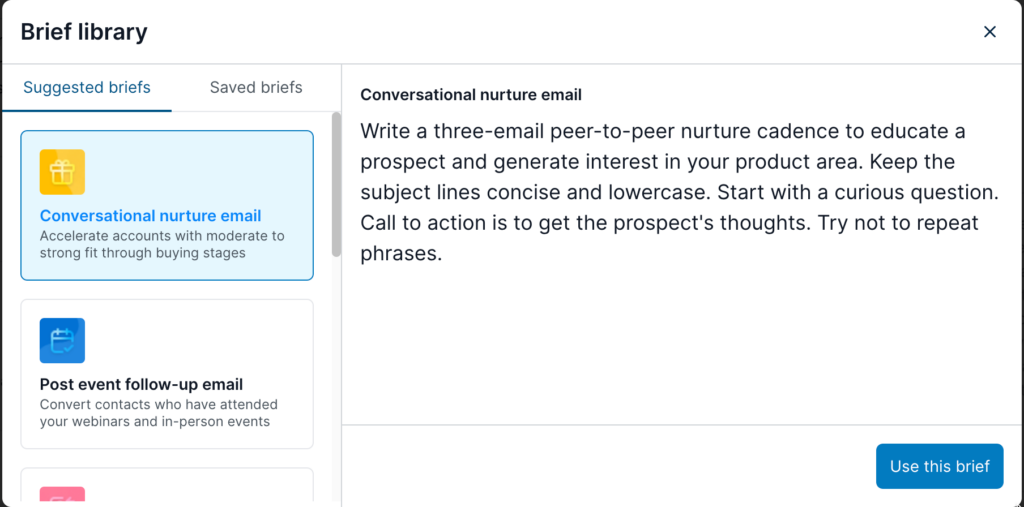One of the greatest advantages that AI offers B2B sellers and B2B marketers is the ability to create automated prospecting strategies that are highly scalable.
Buyers prefer personalized communication, but without AI’s assistance, it’s too time-consuming and costly for human employees to personalize prospecting emails at high volumes — let alone automate those campaigns.
But the advent of generative AI has made personalized automated prospecting possible. Now, you can use the data in your CRM to tailor messages to individual interests, buyer personas, and other characteristics without needing to manually build out a separate campaign for each micro-segment.
Layering in intent data — information about which buyers are actively seeking your services — makes for even smarter campaigns.
Combining generative AI and intent data results in:
- Quicker campaign creation
- Smarter targeting of high-impact buyers
- More personalization across your touchpoints
- Increased pipeline and higher engagement
- Fewer manual tasks
Companies that use the power of AI with intent data will generate more opportunities while lowering their operating costs.
How Generative AI Scales Personalization — A First Step Toward Automated Prospecting
Sellers spend far too much time researching prospects and crafting personalized outreach for buyers. Writing even a handful of emails per day that speak directly to individuals’ unique pain points can be a major time suck — and if they go unread, then it’s a net negative for the business.
But generative AI tools for sellers and marketers — like the AI Writer feature in 6sense’s Conversational Email — enable users to craft personalized emails for different audiences and goals within minutes.
When an AI has been properly “trained” with background information and creative direction, users can input a prompt with:
- Their exact goal for a campaign
- The intended audience
- Editorial voice/tone
- And any other requirements
The AI will then generate a series of emails that speak directly to the intended audience — and will be personalized for the interests of the specific contact.

Instead of spending hours crafting personalized outreach across different target audiences, a BDR could create multi-email campaigns across multiple industries and titles within minutes. This frees them up for more conversation and follow-up with their buyers.
Why Intent Data Transforms Generative AI Output into Automated Prospecting
Intent data are the signs and signals a buyer gives off that alert you to their interest in your products and services.
Some of the activities that reveal intent include:
- Visiting product pages on your website
- Reading your content
- Searching for keywords related to your industry
- Visiting third-party industry websites
- Reading review websites that compare your products with competitors’
6sense makes it possible to capture these usually anonymous activities and associate the buying signals with specific accounts. This makes it possible to understand which buyers are actively in-market for your products or services.
When you take this critical real-time intelligence about your buyers and layer it over your generative AI efforts, you suddenly have dynamic, automated prospecting.
Here’s an example of how that would look.
Sales Prospecting Automation Example
A seller at ACME Co. is responsible for the Midwest region, which encompasses over 100 different target accounts. Rather than arbitrarily working her way through her account list and sending impersonal emails without knowing if the company is even interested, she decides to leverage 6sense intent data and generative AI.
She starts by creating a dynamic segment with 6sense targeting accounts that are showing high intent for a specific product. She then moves over to the AI Writer tool within the AI email assistant, Conversational Email, and writes the following-prompt:
“Create a three-email sequence for a high-intent Director-level audience. Include specific proof points for the value of [Product]. Reference [Relevant Existing Customer]’s case study and provide a link to read more. Include a reference to our ability to drive more sales for their specific company. At the end of the email ask if they would be interested in a 15-minute demo to learn more about [Product].”
Within AI Writer, the seller tells the tool to reference specific intent keywords related to the product she is trying to sell.
After checking the output of the AI tool, she loads those emails into a Conversational Email workflow builder and dictates what should happen for replies, non-responses, and follow-up cadences. This process is simple and easy to do by using templates that align to a user’s goals.

She then targets this email campaign to her dynamic segment, meaning that as accounts meet the criteria for the segment, they’ll be automatically enrolled in the campaign.
After only a few minutes of effort, this seller has created an automatic prospecting workflow that’ll deliver personalized emails to her most important accounts, which increased the chances of opening an opportunity and decreasing the amount of time she needs to spend chasing these buyers.
Conclusion
AI for sales prospecting is just coming into regular use, but there are already ways it can save tons of time while driving high-quality pipeline. Leveraging generative AI with intent data is an easy way to create scalable automated prospecting.



